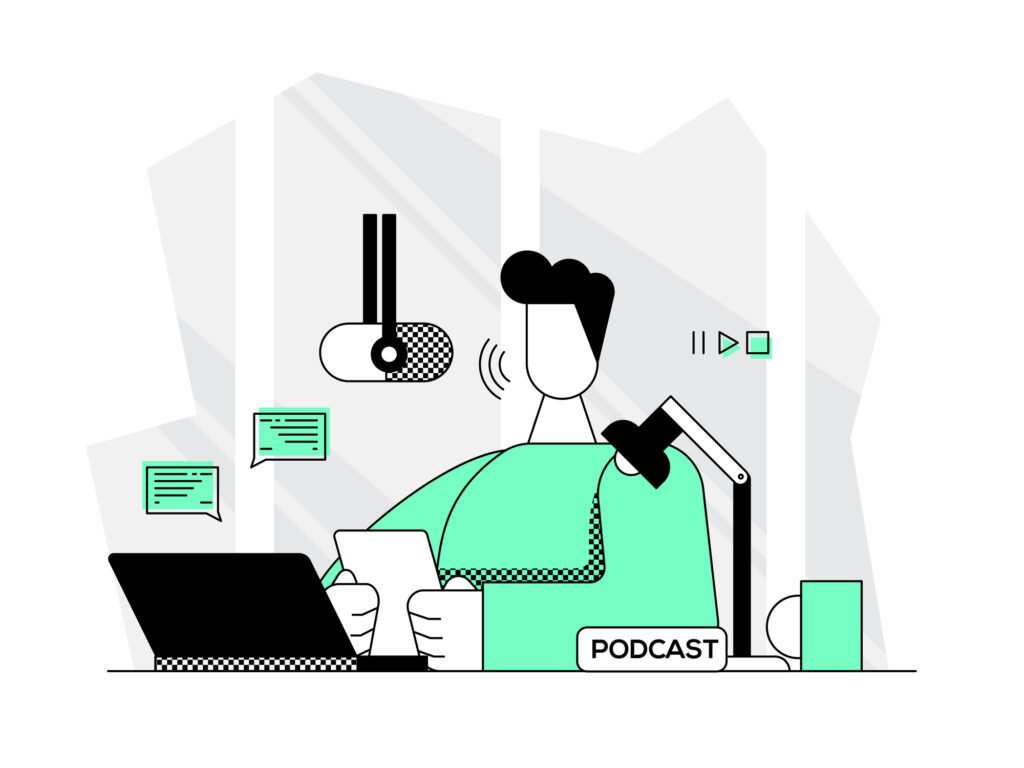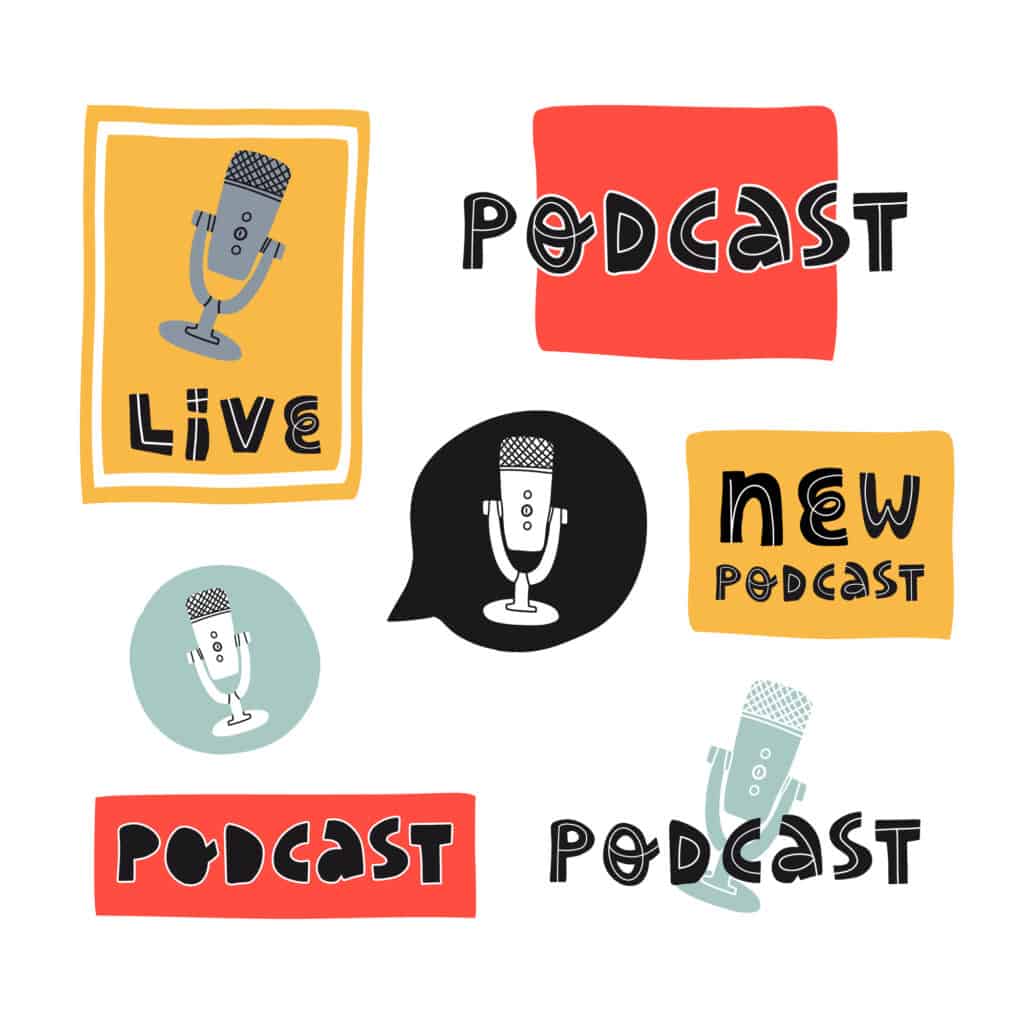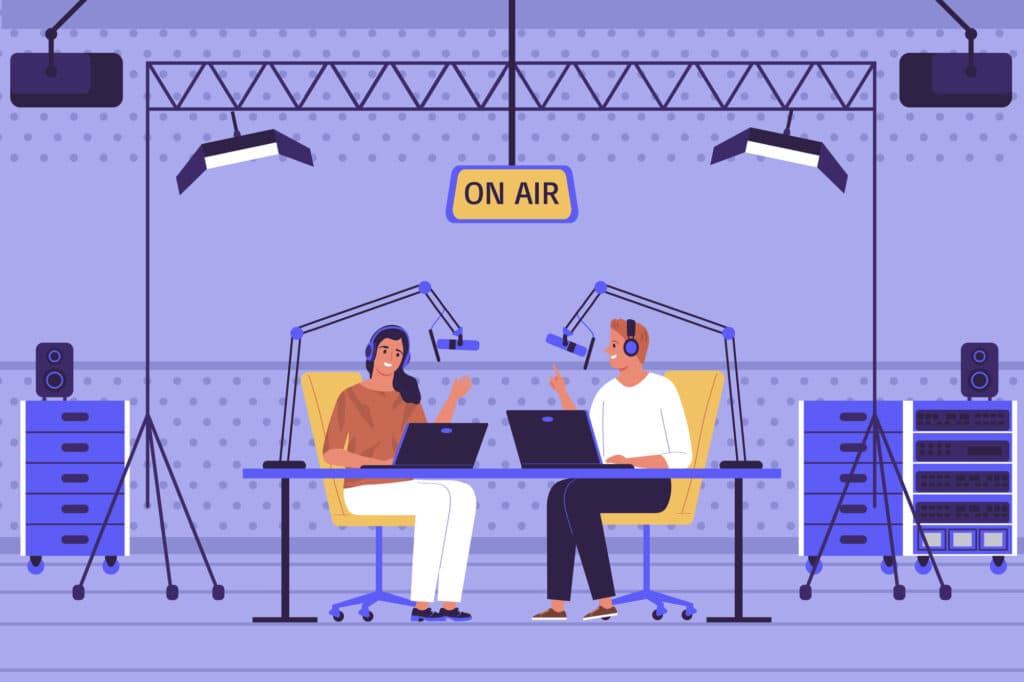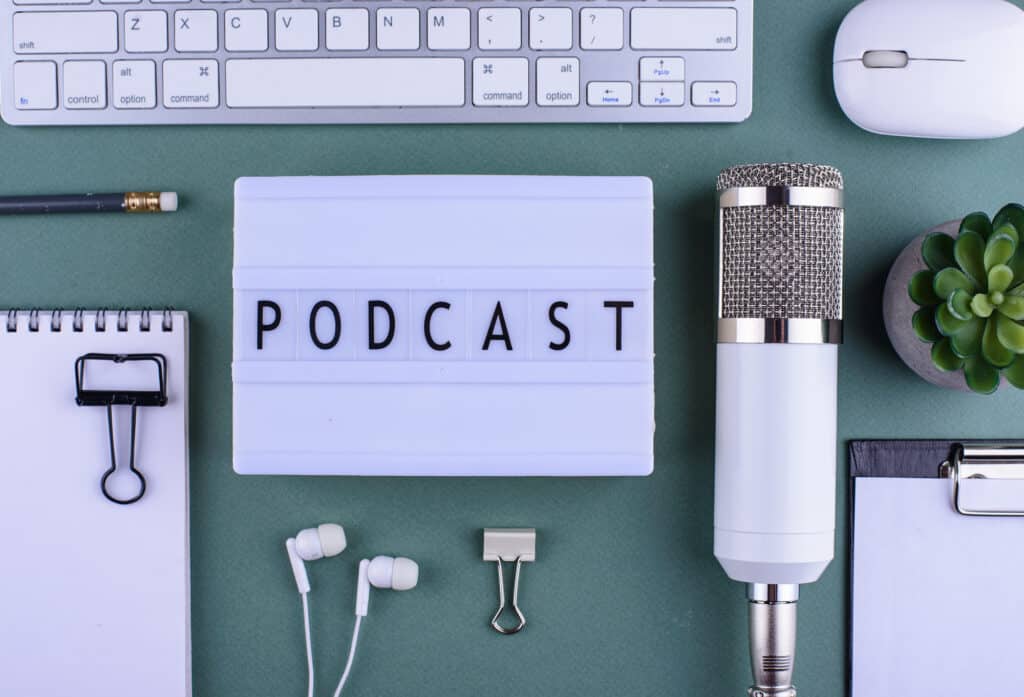
Download Your Free
Ultimate Podcast
Launch Checklist
Imagine turning your passion for conversation into a thriving podcasting business.
That’s what many have done, transforming their ideas into series that captivate millions.
You’re about to dive deep into the world where voices become brands and every episode can open doors to new opportunities. You’ll get the scoop on choosing a niche, branding with flair, setting up shop technically speaking, and crafting content that keeps listeners hitting play. Not just another creative outlet; podcasts provide serious business leverage—think customer trust and an ever-growing audience base. By the end of this journey, you’ll know how to make waves in podcasting waters teeming with two million active casts.
Table of Contents:
- Understanding the Podcasting Business Landscape
- Identifying Your Niche in Podcasting
- Crafting Your Podcast Brand Identity
- Setting Up Your Podcast Studio
- The Technicalities of Recording & Editing
- Getting Your Podcast Out There
- Leveraging Social Media & Other Promotional Strategies
- The Monetization Game Plan
- Sustaining Growth & Engagement Long-Term
- Conclusion
Understanding the Podcasting Business Landscape
The podcasting business is booming, and savvy entrepreneurs are tuning in to its potential. With about 2 million active podcasts and more than half of the U.S. population listening in, it’s clear why this medium has become a sound investment for online business owners looking to amplify their voice.

The Rise of Podcast Popularity
People listen to an average of eight podcast episodes per week—a stat that should make any business owner perk up their ears. This uptick isn’t just casual background noise; it signifies a shift towards audio content as a primary source of information and entertainment.
To start your own successful podcast, you’ll need to resonate with your target audience by offering in-depth insights or spinning tales that captivate—whatever fits your chosen subject matter best. Picture this: each episode is like planting a seed in the MoneyTreeSeed.com garden—the more quality content you provide, the richer the harvest.
Establishing Business Credibility
A top-notch podcast can skyrocket your brand’s credibility faster than trying to break through on crowded platforms like Google Podcasts or Apple Music alone. By sharing valuable knowledge through engaging stories or interviews with guests from within your industry niche, you build trust with listeners who then look forward to downloading episodes weekly—or even joining premium subscription models if they love what they hear.
Identifying Your Niche in Podcasting
Finding your unique angle in the podcast world is a bit like discovering an uncharted island. It’s exciting, but you’ve got to be smart about staking your claim. With around 2 million active podcasts out there, it’s clear that people listen—and they’re eager for content that speaks directly to them.
Analyzing Market Saturation
You wouldn’t open a coffee shop without checking how many are already on the block, right? So when choosing a podcast topic and target audience, look at what’s out there first. Are specific podcasts flooding the market or is there room for something fresh? By standing out in a crowded podcasting market with something different—maybe even quirky—you can make sure listeners tune into your show instead of another rerun.
A deep dive into popular podcast directories like Google Podcasts might reveal too many shows covering broad strokes. But don’t let this deter you. Maybe those generalist shows aren’t offering in-depth insights that could hook an audience seeking expertise on narrower topics—this gap could be where you shine.
To nail down what makes your show distinct, consider visiting The Art and Science of Naming Your Podcast. A descriptive title not only draws interest but also helps build online presence through search engines—an essential step since over half of U.S listeners rely on these platforms to find new episodes each week.
Your chosen niche should reflect both passion and knowledge because successful podcasts thrive when their creators genuinely care about the subject matter—which naturally translates into quality content for their audience engagement journey.
Crafting Your Podcast Brand Identity
Think of your podcast as a tree. Its name is the seed from which everything grows. You need something catchy, yet reflective of what you’ll be dishing out each episode.
Choosing an Engaging Name
Your podcast’s name isn’t just a label; it’s the first handshake with your audience. Get creative and make sure it sticks in people’s minds like gum on hot pavement—without being tacky, of course. A clever twist or pun can work wonders for SEO and help listeners remember you among the two million active podcasts vying for their attention.
An effective title should act like a magnet pulling at your target audience’s curiosity while hinting at what lies beneath the surface. Think ‘The Daily Spoonful’ instead of ‘Daily News Recap’. It gives flavor to what might otherwise be bland content offerings in search engines.
Visual Branding Essentials
A stunning cover art serves as both welcome mat and window display—it invites folks in and tells them about all the good stuff they’ll find inside your weekly audio banquet. If graphic design feels more complex than rocket science, don’t fret. Platforms such as Canva let even novices create professional-looking designs that resonate with their brand identity without needing a degree in visual arts.
The colors, fonts, and imagery used must not only look great but also echo the essence of your subject matter to make sure those scrolling through Google Podcasts take notice. Remember: Just because you have royalty-free music doesn’t mean skimp on visually free expression.
Setting Up Your Podcast Studio
So, you’ve decided to start a podcast. Smart move. With millions of active podcasts out there and over half the U.S. population tuning in, it’s clear that audio is where it’s at.
Getting Equipped with Quality Gear
Your first step is to get your hands on some quality gear without breaking the bank. Whether you’re eyeing a Blue Yeti for its ease of use with a USB port or considering condenser microphones for their studio-grade sound, choosing the right microphone can make all the difference between an amateur setup and one that screams professional. And let’s not forget about headphones; they are essential for monitoring your recording sessions.
You might be tempted by high-end options but remember – great content beats fancy equipment any day. A simple yet reliable USB microphone could be just what you need to record audio that makes people listen and feel comfortable diving into your episodes week after week.
The Right Software for Editing
No matter how smooth those interviewing skills are or how crisp your new mic sounds, raw audio usually needs a bit of polish before hitting listeners’ ears – this is where editing software steps in like GarageBand (for Apple devices) or Audacity (for any device) can save the day—and not just because they’re free.
If Adobe Audition seems more up your alley due to its advanced features tailored toward podcast production – go for it. The key here is finding tools that let you trim down tangents and tweak levels so each episode shines as brightly as possible when released into popular podcast directories like Google Podcasts or even directly onto your own site via RSS feed.
Jump into podcasting with the right gear—think quality mics and headphones that don’t cost a fortune. Remember, it’s your content that’ll keep listeners coming back.
Edit like a pro using tools such as GarageBand or Audacity to polish your audio, ensuring every episode is crisp and clear for your audience.
The Technicalities of Recording & Editing
Covers techniques for recording clear audio as well as tips for editing episodes effectively.
Mastery Over Microphones
Discuss optimal microphone use during recording sessions to ensure professional sound quality.
When it comes to recording your podcast episodes, the right microphone is like a magic wand. It won’t turn a pumpkin into a carriage, but it can transform amateur audio into professional-sounding content that makes listeners tune in again and again. Optimal use of microphones during sessions is key; whether you choose USB or condenser microphones with an XLR connection depends on your needs and setup. A popular choice for many budding podcasters is the Blue Yeti because of its versatility and ease—just plug it into a USB port, and you’re ready to record clear sound.
To make sure your voice sounds as crisp as an autumn morning, spend time finding the perfect spot in your room where echo takes a back seat. Remember: Your audience wants clarity not just from what you say but how they hear it too.
Navigating Audio Editing
Offer strategies for efficient editing workflows that maintain listener engagement throughout each episode.
Now let’s talk about editing software – think of this as the scalpel that lets you carve out unwanted bits from your masterpiece. For those starting out, GarageBand for Apple devices or Audacity offer robust features without denting wallets since both are free tools allowing anyone to create clever cuts and smooth transitions easily.
Audiences expect quality content which means learning these programs will help keep engagement high throughout each episode by ensuring no awkward silences or jarring jumps distract them from your message. GarageBand caters well to Mac users while Audacity works across various platforms giving flexibility regardless of hardware preference—but remember always double-check levels before hitting publish.
Master your mic to make sure your podcast sounds top-notch. Find that sweet spot in your space where echo is minimal and clarity is king.
Edit like a pro using free tools like GarageBand or Audacity, cutting out the fluff for smooth, engaging episodes every time.
Getting Your Podcast Out There
You’ve put in the work, crafting episodes that you’re proud of. Now it’s time to share your podcast with the world. But where do you start? Think about planting a tree; your podcast is the seed and hosting platforms are the soil—necessary for growth.

Choosing Hosting Solutions
Selecting a podcast host like Libsyn or checking out services such as Buzzsprout, can be much like picking a coffee shop to meet friends—it needs to feel comfortable and fit your style. Each platform offers unique features that cater to different needs, whether it’s analytics or ease of distribution.
Publishing and promoting your podcast episodes become simpler when using these hosts because they automatically generate an RSS feed, making sure listeners tune in no matter which app they use—from Apple Podcasts to Google Podcasts. They help build an online presence by pushing content through popular podcast directories where many people listen each week.
To stand out among approximately 2 million active podcasts requires more than just uploading audio files—you need strategies that make listeners subscribe eagerly, anticipating every release schedule. A descriptive title for each episode helps search engines understand what you offer while clever cover art can add elements of visual appeal that entice potential fans scrolling through their feeds.
A successful launch isn’t only about finding homes on multiple media channels but also ensuring consistent quality content so loyal followers keep coming back for more—and maybe even download episodes for offline enjoyment during their busy weeks.
Leveraging Social Media & Other Promotional Strategies
When it comes to getting your podcast noticed, think of social media as the megaphone that amplifies your voice in a crowded room. It’s not just about posting; it’s about crafting messages that stick and conversations that resonate.
Savvy Social Media Marketing
Imagine Twitter or Instagram as bustling digital cities where every street corner offers the chance for discovery. To stand out, you’ve got to engage with your audience on these platforms—strike up genuine dialogues, share snippets of intriguing content, and offer peeks behind-the-scenes. This isn’t just expanding an online presence through podcasting; it’s building a community eager to press play.
A tweet can spark curiosity like lightning in a bottle—a retweet then becomes the thunderous echo reaching new ears. On Instagram, let visuals do the talking: post captivating images or quotes from recent episodes that give followers something tangible to connect with. Leveraging social media channels for promotion means turning passive scrollers into active listeners—and potential subscribers.
To boost this engagement further, GarageBand melodies could serenade clips shared on Facebook while carefully crafted sound bites edited via Audacity can tease upcoming episodes on LinkedIn—an orchestra playing different tunes tailored for each platform’s unique audience.
The magic lies not only in what you say but how often you say it too—a release schedule synced across all accounts makes sure no one misses when new episodes drop. And don’t forget podcasts week essentials like hashtags—they’re like breadcrumbs leading enthusiasts right back to your show among millions of active podcasts streaming globally.
Your goal? Transform passive scrolls into passionate subscribes by making every post an invitation—to listen, laugh, learn—and ultimately join your growing tribe of loyal fans tuning into every beat of your podcast’s heart.
Think of social media as your podcast’s megaphone, turning passive scrollers into passionate subscribers. Engage with genuine conversations on Twitter and Instagram, share enticing content snippets, and use platform-specific strategies like GarageBand melodies on Facebook or Audacity-edited sound bites on LinkedIn to lure listeners in.
The Monetization Game Plan
Picture your podcast as a tree. Just like any sapling, it starts from a seed—your content—and grows with care and the right strategies. Now, let’s talk money; how do you make sure this tree bears fruit? That’s where the monetization game plan comes into play.
Tapping Into Sponsorships
Sponsorship opportunities are ripe for picking if you know where to look. Businesses thrive on visibility, and what better way to get seen than by aligning with podcasts that share their values or target audience? You can start small, reaching out to local brands who might be interested in growing alongside you. As your listenership blooms—a lush 57% of the U.S population tunes into podcasts—you become more attractive to bigger sponsors looking for established shows that guarantee engagement.
To carve out these deals effectively requires an understanding of both parties’ needs. Your sponsor wants exposure but also alignment with their brand message; show them how sponsoring your episodes can offer in-depth access to engaged listeners eager for related products or services.
Pioneering Premium Content Models
Crafting premium content is akin to nurturing a rare plant within your garden—it offers something extra special that isn’t available elsewhere. But remember: people listen when they feel comfortable and see value in what they’re spending time on; consider whether exclusive paid episodes could deepen listener loyalty while adding another revenue stream.
You have crowdfunding patronage platforms at your disposal too, which act as virtual tip jars—letting those who love what you do give back directly through financial support. Think about integrating merchandise sales branding here as well—the potential reach is significant given that active podcast listeners tune into eight shows per week on average.
Think of your podcast like a growing tree. To make money, you’ve got to have the right plan.
Sponsorships: Start by reaching out to local brands and grow from there. As your audience gets bigger, so do sponsorship opportunities.
Premium Content & Crowdfunding: Offer special content for a fee or ask fans for support directly through platforms like Patreon—and don’t forget about merch.
Sustaining Growth & Engagement Long-Term
Once the launch buzz of your podcast fades, it’s time to roll up your sleeves and keep that momentum going. It’s not just about maintaining an audience but gaining more listeners through continuous improvement. Quality content is king, yes, but adaptation to evolving industry trends and technology is the queen that keeps the kingdom thriving.

Maintaining Consistent Content Creation
Your weekly podcast isn’t just a series of episodes; it’s a commitment to your listeners. Imagine you’re planting a tree with every episode—each one needs regular attention if you want long-term growth. To ensure those branches spread wide, create clever titles for each episode that spark curiosity while keeping them descriptive enough so search engines can help new listeners discover your show.
A successful podcast requires not only great subject matter but also active engagement with social media channels like Twitter or Instagram where people listen in their daily scroll-fests. The challenge? Keep feeding these platforms quality content without making it feel like leftovers from last week’s dinner party.
Adapting With Technology And Trends
The mic you use—the Blue Yeti plugged into your USB port—isn’t just recording audio; it’s capturing moments of connection with audiences across popular podcast directories like Google Podcasts or Apple Podcasts. But don’t let tech intimidate you. Even simple condenser microphones paired with editing software such as Adobe Audition can elevate production value significantly over time.
To stay ahead in this game, adapt by using listener feedback as breadcrumbs leading toward better episodes. It takes time to fine-tune elements from sound design cover art down to even royalty-free music choices which all contribute towards building trust among subscribers who tune in expecting fresh angles on familiar topics every week – make sure they get what they came for.
To keep your podcast growing, focus on fresh content and adapt to new trends. Think of each episode as a tree needing care—nurture it with engaging titles and active social media presence. Embrace technology; use quality mics and editing software to connect better with listeners who crave innovation in every listen.
Conclusion
So you’ve navigated the ins and outs of launching a podcasting business. You now understand its booming popularity and how it can skyrocket your credibility. Key takeaways? Pick a niche that resonates, brand like a boss with snappy names and eye-catching visuals, get the right gear without breaking the bank, edit for impact, host wisely to reach far and wide.
Leverage social media to amplify your voice. Think long-term; build trust as people listen in weekly. Monetize smartly through sponsorships or premium content—remembering patience is key.
Your journey doesn’t end here; it’s just getting started. Keep adapting, stay consistent, keep growing—a successful podcast takes time but offers rich rewards.

Download Your Free
Ultimate Podcast
Launch Checklist




